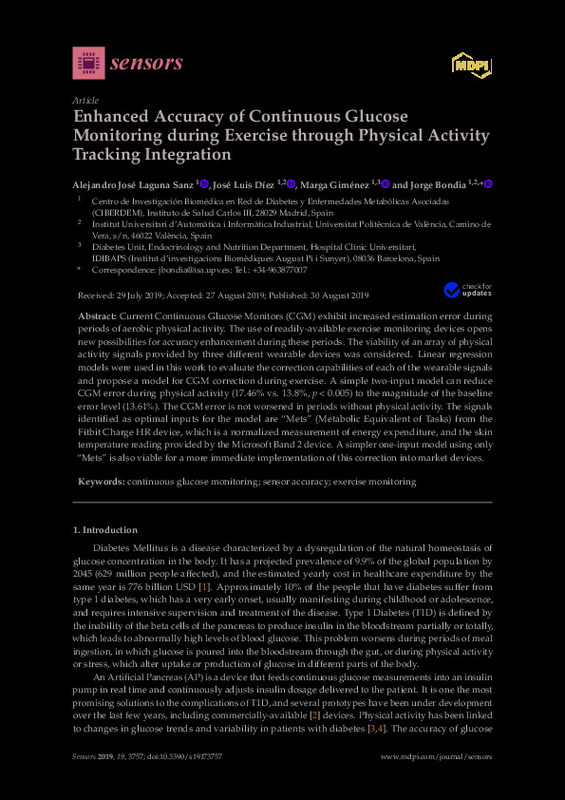JavaScript is disabled for your browser. Some features of this site may not work without it.
Buscar en RiuNet
Listar
Mi cuenta
Estadísticas
Ayuda RiuNet
Admin. UPV
Enhanced Accuracy of Continuous Glucose Monitoring during Exercise through Physical Activity Tracking Integration
Mostrar el registro sencillo del ítem
Ficheros en el ítem
| dc.contributor.author | Laguna Sanz, Alejandro José
|
es_ES |
| dc.contributor.author | Diez, José-Luís
|
es_ES |
| dc.contributor.author | Giménez, Marga
|
es_ES |
| dc.contributor.author | Bondía Company, Jorge
|
es_ES |
| dc.date.accessioned | 2024-01-12T19:02:05Z | |
| dc.date.available | 2024-01-12T19:02:05Z | |
| dc.date.issued | 2019-09-01 | es_ES |
| dc.identifier.uri | http://hdl.handle.net/10251/201894 | |
| dc.description.abstract | [EN] Current Continuous Glucose Monitors (CGM) exhibit increased estimation error during periods of aerobic physical activity. The use of readily-available exercise monitoring devices opens new possibilities for accuracy enhancement during these periods. The viability of an array of physical activity signals provided by three different wearable devices was considered. Linear regression models were used in this work to evaluate the correction capabilities of each of the wearable signals and propose a model for CGM correction during exercise. A simple two-input model can reduce CGM error during physical activity (17.46% vs. 13.8%, p < 0.005) to the magnitude of the baseline error level (13.61%). The CGM error is not worsened in periods without physical activity. The signals identified as optimal inputs for the model are Mets (Metabolic Equivalent of Tasks) from the Fitbit Charge HR device, which is a normalized measurement of energy expenditure, and the skin temperature reading provided by the Microsoft Band 2 device. A simpler one-input model using only Mets is also viable for a more immediate implementation of this correction into market devices. | es_ES |
| dc.description.sponsorship | This work was supported by the Spanish Ministry of Economy, Industry and Competitiveness (MINECO) (Grant Number DPI2016-78831-C2-1-R), the European Union (FEDER funds), and the Vicerectorate of Research, Innovation and Technology Transference from the Universitat Politecnica de Valencia (Grant Number PAID-06-18). We would like to acknowledge the work performed by Josep Vehí, Lyvia Biagi, Ignacio Conget and Carmen Quirós. We thank all the participants and clinical staff who participated in clinical acquisition and pre-formatting of data for study, without whom none of this work would have been possible. | es_ES |
| dc.language | Inglés | es_ES |
| dc.publisher | MDPI AG | es_ES |
| dc.relation.ispartof | Sensors | es_ES |
| dc.rights | Reconocimiento (by) | es_ES |
| dc.subject | Continuous glucose monitoring | es_ES |
| dc.subject | Sensor accuracy | es_ES |
| dc.subject | Exercise monitoring | es_ES |
| dc.subject.classification | INGENIERIA DE SISTEMAS Y AUTOMATICA | es_ES |
| dc.title | Enhanced Accuracy of Continuous Glucose Monitoring during Exercise through Physical Activity Tracking Integration | es_ES |
| dc.type | Artículo | es_ES |
| dc.identifier.doi | 10.3390/s19173757 | es_ES |
| dc.relation.projectID | info:eu-repo/grantAgreement/AEI//DPI2016-78831-C2-1-R//SOLUCIONES PARA LA MEJORA DE LA EFICIENCIA Y SEGURIDAD DEL PÁNCREAS ARTIFICIAL MEDIANTE ARQUITECTURAS DE CONTROL MULTIVARIABLE TOLERANTES A FALLOS/ | es_ES |
| dc.relation.projectID | info:eu-repo/grantAgreement/UPV-VIN//PAID-10-19//Mejora de prestaciones del páncreas artificial ante ingestas y ejercicio mediante observadores de perturbaciones y técnicas de compensación de retardos./ | es_ES |
| dc.relation.projectID | info:eu-repo/grantAgreement/UPV//PAID-06-18/ | es_ES |
| dc.rights.accessRights | Abierto | es_ES |
| dc.contributor.affiliation | Universitat Politècnica de València. Escuela Técnica Superior de Ingenieros Industriales - Escola Tècnica Superior d'Enginyers Industrials | es_ES |
| dc.description.bibliographicCitation | Laguna Sanz, AJ.; Diez, J.; Giménez, M.; Bondía Company, J. (2019). Enhanced Accuracy of Continuous Glucose Monitoring during Exercise through Physical Activity Tracking Integration. Sensors. 19(17):1-14. https://doi.org/10.3390/s19173757 | es_ES |
| dc.description.accrualMethod | S | es_ES |
| dc.relation.publisherversion | https://doi.org/10.3390/s19173757 | es_ES |
| dc.description.upvformatpinicio | 1 | es_ES |
| dc.description.upvformatpfin | 14 | es_ES |
| dc.type.version | info:eu-repo/semantics/publishedVersion | es_ES |
| dc.description.volume | 19 | es_ES |
| dc.description.issue | 17 | es_ES |
| dc.identifier.eissn | 1424-8220 | es_ES |
| dc.identifier.pmid | 31480343 | es_ES |
| dc.identifier.pmcid | PMC6749476 | es_ES |
| dc.relation.pasarela | S\404273 | es_ES |
| dc.contributor.funder | AGENCIA ESTATAL DE INVESTIGACION | es_ES |
| dc.contributor.funder | European Regional Development Fund | es_ES |
| dc.contributor.funder | UNIVERSIDAD POLITECNICA DE VALENCIA | es_ES |
| dc.contributor.funder | Universitat Politècnica de València | es_ES |
| dc.subject.ods | 03.- Garantizar una vida saludable y promover el bienestar para todos y todas en todas las edades | es_ES |








